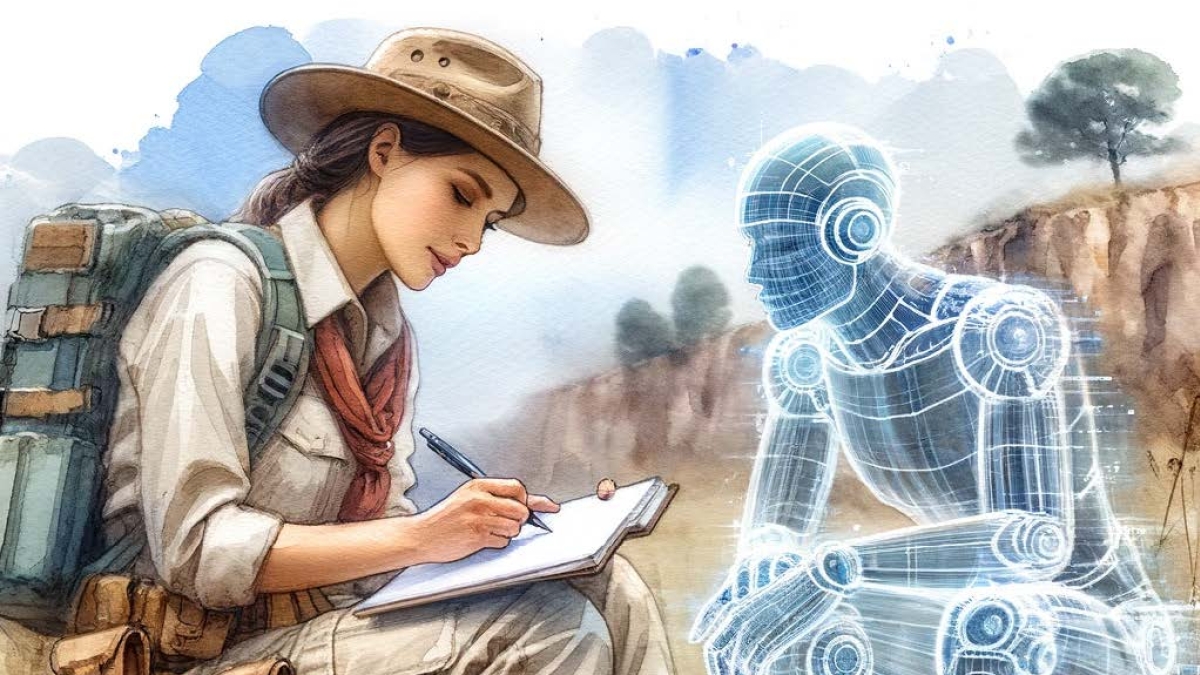Accelerating science through immersive virtual reality

AI-generated image courtesy Kip Hodges/ASU
With initial funding from the Office of the President and Knowledge Enterprise, the newly established Digital Discovery Initiative at Arizona State University is poised to revolutionize observational scientific research.
It will bridge the gap between technological advances like virtual reality, remote sensing and data visualization and the need for expertise to reproduce natural environments in a virtual way.
“Arizona State University recognizes the powerful potential of immersive virtual technology, including its capacity to unlock new scientific frontiers,” said ASU President Michael M. Crow. “Building off of ASU’s expertise in the VR realm, we believe that the Digital Discovery Initiative can meaningfully enhance the future of discovery and team science.”
The initiative is a groundbreaking university effort to conceptualize, develop, implement and promote telescience — the operation of robots and sensor networks to gather data about distant objects or environments — and metascience — direct scientific research in the metaverse.
“Knowledge Enterprise is thrilled to help fund ASU’s Digital Discovery Initiative,” said Sally Morton, executive vice president of ASU Knowledge Enterprise. “Accelerating scientific understanding through immersive virtual reality will allow us to explore, experiment and observe natural phenomena in ways that were previously unimaginable.”
While other universities and research institutions are also exploring the value of virtual reality for scientific visualization purposes, the initiative's ambitious long-term goal is to move beyond visualization to pioneer direct, observational scientific research on high-resolution, digital replicates of natural environments — which they refer to as virtual environments.
“Recent advances in virtual reality — in particular, the development of opportunities for the immersion of research teams in virtual environments — make it possible to reimagine scientific field research,” said Digital Discovery Initiative Director Kip Hodges, a Foundation Professor in the School of Earth and Space Exploration. “We can make it more inclusive, broadening the cohort of scientists who can study remote or difficult-to-access targets for scientific exploration. By bringing these targets to more researchers, we can build scientific consensus more broadly and more quickly.”
The initiative will focus on developing highly high-resolution digital twins (detailed, accurate and realistic digital models) of natural planetary landscapes, enhancing them with handheld or embedded biological, chemical or physical sensor data, then rendering the enhanced models as virtual environments.
A key element of the work is making these environments immersive so that researchers can work collaboratively in them as avatars. To achieve this, the initiative is leveraging the successes of ASU’s Dreamscape Learn in the realm of undergraduate education.
“Dreamscape Learn provides a model for DDI. Just as Dreamscape Learn is revolutionizing undergraduate education, DDI hopes to revolutionize field scientific research as well as professional training of field researchers,” Hodges said.
During its first year of existence, the Digital Discovery Initiative established a core group of faculty, staff and student researchers who have established advanced strategies to acquire photogrammetric datasets for natural environments; have developed pipelines to convert these datasets into very high-resolution 3D models; and have started rendering these models as immersive virtual environments using Dreamscape software.
Researchers have developed relationships with a variety of external university, corporate and governmental collaborators to leverage immersive virtual reality research for the scientific exploration of environments as varied as coral reefs and the cratered surface of the moon.
“The ideas at the core of DDI have been well-received by the international science and engineering communities," Hodges said. "So far, we’re only scratching the surface of the possible applications out there. I’m excited to see how the initiative evolves as we broaden collaborations across ASU and beyond.”
More Science and technology

ASU and Deca Technologies selected to lead $100M SHIELD USA project to strengthen U.S. semiconductor packaging capabilities
The National Institute of Standards and Technology — part of the U.S. Department of Commerce — announced today that it plans to award as much as $100 million to Arizona State University and Deca…

From food crops to cancer clinics: Lessons in extermination resistance
Just as crop-devouring insects evolve to resist pesticides, cancer cells can increase their lethality by developing resistance to treatment. In fact, most deaths from cancer are caused by the…

ASU professor wins NIH Director’s New Innovator Award for research linking gene function to brain structure
Life experiences alter us in many ways, including how we act and our mental and physical health. What we go through can even change how our genes work, how the instructions coded into our DNA are…